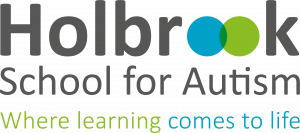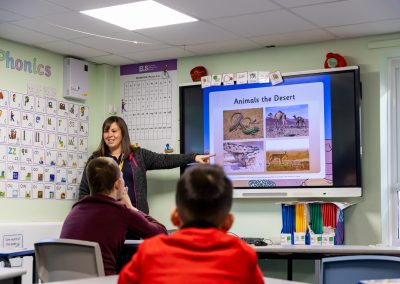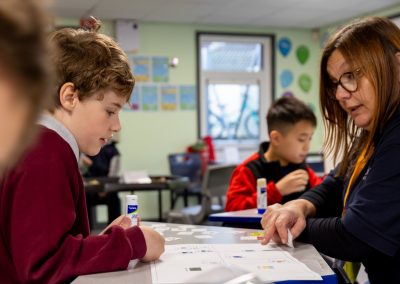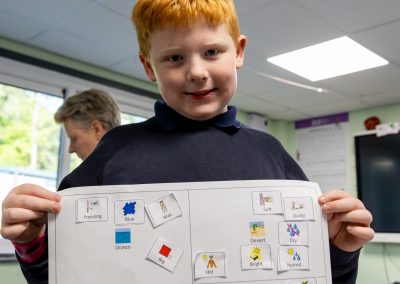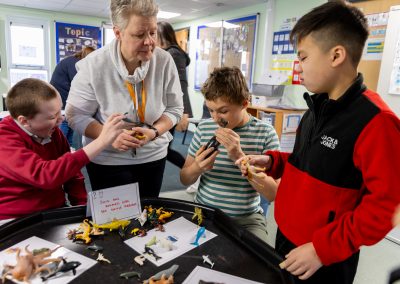The Holbrook Curriculum
The Holbrook curriculum fulfils every individual’s potential
Holbrook School for Autism seeks to provide a broad, balanced, relevant, meaningful and motivating curriculum to develop the specific strengths, needs, interests and aspirations of our students. We have designed and implemented our whole school curriculum offer to meet the wide range of learners we have in our school. The curriculum is used to develop student confidence, interest in and understanding of the world. Differentiated, personalised provision enables students to become increasingly independent as they transfer learning between school, home, residential and the wider community.
Holbrook School for Autism aims to ‘make learning come to life’. We provide specialist education and care for children and young people with autism and learning disabilities aged 4-19. We teach a broad curriculum, intended to meet the needs of individuals with autism as successfully as possible. Our school curriculum is designed to ensure we provide a bespoke autism-specific curriculum tailored to the needs of all our students. We aim to provide a curriculum that prepares students as effectively as possible for life after school. Our autism-specific curriculum is primarily focused around the four areas of the SEND code of practice. The curriculum structure is devised around four pathways. It is important to remember that a student may require elements of two pathways or flow between pathways during their journey at Holbrook School for Autism.
Our linear curriculum is based on the content of EYFS, the National Curriculum and the Preparation for Adulthood Framework. We recognise that some of our students, due to their complex needs, may never gain certain skills. Our lateral curriculum is focused on progress made against each student’s EHCP. Each student has a personalised provision evident within their ‘My Plan’. With these we work together with students, parents and professionals to decide individual outcomes. The provision determined in the ‘My Plan’ then informs the student’s pathway. Each class has its own base and access to a range of specialist teaching areas including food technology, computing, sports hall, library, horticulture area, forest school and sensory rooms.
Our Pathways
Students are not placed in cohorts based on their chronological age; they are placed in class groups dependent on their cognitive, sensory, social, emotional and communication needs. Classes are organised into our four curriculum pathways: ‘Stream‘, ‘River‘, ‘Ocean‘ and ‘Hub‘.
Raindrops
Stream
River
Ocean
Waterfall
Curriculum Implementation
All students at Holbrook School for Autism have a ‘My Plan’ document, which highlights the context for their educational provision. These are specifically tailored around the student’s EHCP. The four areas are taken from the four key areas of the SEND code of practice for teaching pupils with autism. This identifies the needs of each individual student. The ‘My Plan’ identifies the needs of each individual student primarily based on EHCP provision and outcomes. These plans support teachers to create appropriate learning environments, identify specific areas of need and design informed class timetables. Provision maps for our four pathways have been devised to inform ‘My Plan’.
A student may require elements of two pathways or flow between pathways during their journey at Holbrook School for Autism. Student EHCP’s inform a student’s ‘My Plan’. The provision determined in the ‘My Plan’ then informs the student’s pathway.
Case Study – Bringing the Learning to Life – ‘Going to the Hairdressers’
2022-2023 Assessment and Progress
Curriculum Areas
The curriculum is delivered through key themes identified in a four-year curriculum map to ensure the full breadth of study through a thematic approach linked to the needs and targets of the pupils. Curriculum leaders are established and lead the curriculum through the school and support teaching staff appropriately. The curriculum has a developmental focus allowing students to engage in meaningful activities which are both challenging and relevant to the students’ identified needs. Programmes to meet physical, personal and other therapy needs are an integral part of our planning. Our curriculum is designed to fulfil our school purpose: ‘To educate and empower our young people to develop the attitudes, skills and courage to succeed’. Curriculum planning is based on the National Curriculum to ensure it is broad and balanced.
Reading at Holbrook School for Autism
At Holbrook School for Autism we aim to foster a love and enjoyment of reading which encourages all children to read regularly, experiencing a selection of books from a wide range of genres and authors. We value reading as a life skill and we are committed to our pupils becoming lifelong readers who are able to read for pleasure and apply their skills functionally. We want pupils to develop a love of reading and be able to understand more about the world in which they live, through the knowledge they gain from texts. Reading will also allow them to access the world they live in meaningfully.
Our reading curriculum is designed with the understanding that each pupil will have unique starting and destination points. It is split into four separate curriculums areas, those being the Stream, River, Ocean and Hub pathways. Reading will look varied across the pathways and have different intentions based on student’s reading stages of development. For some students, they will access learning through immersive interaction with texts through sensory stories and interactive technology which makes reading more accessible for high quality learning. For some of our students, reading is an emergent skill and includes tracking, interaction with objects, and recognition of shapes, contrasts, people and faces amongst many other things. As students develop their reading skills further it incorporates recognising Makaton signs, recognising Communication InPrint symbols and common environmental print such as warning signs, information texts and timetables.
Many of Holbrook’s students also read in the more traditional sense of the word and are able to decode text using picture books and indeed many students are able to read and comprehend books independently. Students at Holbrook read to recognise words but also comprehend texts to explore and understand their surroundings especially through social sight vocabulary.
Phonics is one of the core strategies used across school to support the student’s reading development. All staff understand and strongly promote the learning of phonics throughout school and is delivered daily across school. Phonics is taught using a systematic and synthetic programme called ‘Essential Letters and Sounds’. Teachers may need to differentiate the pace, learning techniques and supporting resources, such as symbols (Widgit), based on the needs of their pupils. A lot of revision and repetition is built-in, as well as the application of phonic skills in all reading and writing. Students at the very early stages of their phonics development will engage with phase one phonics alongside communication development and will heavily rely on AAC strategies such as objects of reference, photos and symbols and sensory exploration rather than the traditional learning programme. As students develop their phonic awareness, they will access the scheme in line with their abilities and development needs. The programme will have a core focus and staff will follow the teaching and learning requirements within this but an appreciation of our student’s needs may need the scheme to be highly adaptable while keeping the main aspects at the core. Please take a look at our phonics development poster which showcases the journey we have made to date.
Pupils also apply and practise their reading in the community and in all areas of the curriculum. Our students gain skills that enable them to access our local communities functionally. Our approach to teaching and learning in our school community enables all students to have the best possible skills set they can achieve to be ready for their next steps in life.
Regular and ongoing assessment takes place throughout the year and this information is used to plan for future lessons, ensuring students are challenged and supported appropriately. Pupils develop skills for life through reading, completing pre entry, entry level qualifications in KS4 and KS5 demonstrating their ability to read.
Mathematics at Holbrook School for Autism
At Holbrook School for Autism, we believe that every student can develop their mathematical thinking in a way that is meaningful and relevant to their everyday life. From counting two slices of bread to managing money at work, mathematical skills help our students grow in independence, confidence, and opportunities for the future.
We use high-quality resources and adapted schemes, including Numicon and White Rose Maths, alongside a strong emphasis on concrete, pictorial, and abstract learning. Wherever possible, maths is linked to real-life situations to help students apply their skills outside the classroom.
How We Teach Maths
Raindrops Pathway: Early maths skills are developed through sensory play, exploration, and real-world resources. Using an adapted White Rose Reception scheme alongside Numicon, pupils build a strong foundation in number, pattern, and size, with opportunities for stretch where appropriate.
Stream Pathway: This pathway focuses on building early thinking and organisational skills through structured routines and weekly attention sessions. Learning links to the White Rose Nursery Scheme with a focus on Numicon and hands-on practical tasks. There is an increasingly functional focus from Key Stage 3 onwards.
River Pathway: Students take part in at least three maths sessions a week using a carousel approach that includes 1:1 support, small group work, and sensory tasks. Learning follows an adapted version of the White Rose Maths primary curriculum and includes Functional Maths weeks at KS3-4. Accreditation includes AQA Entry Level Certificate (Entry Level 1-2) at KS4 and functional maths ASDAN units at KS5.
Ocean Pathway: Students take part in at least three maths sessions a week using concrete and pictorial methods to deepen their abstract understanding. Depending on need, students work towards GCSE Foundation or Entry Level Certificate at KS4, with opportunities to develop functional maths skills at KS5 to support Preparation for Adulthood.
Waterfall Pathway: Students receive formal, structured maths lessons three times per week, with a focus on fluency activities and addressing misconceptions. The adapted WRM curriculum builds strong number sense and problem-solving skills. Regular ‘Apply Weeks’ link maths to real-life contexts.
Supporting Maths at Home
We encourage families to celebrate everyday maths, such as:
-
- Spotting numbers when out and about.
- Counting objects during routines.
- Applying weighing and measuring skills while cooking together.
- Using travel timetables or planning journeys as a family in the community.
- Handling money and taking an active role in shopping activities
Simple activities like these can make a big difference to building confidence and real-world skills.
Science at Holbrook School for Autism
In an increasingly technological age, we believe that it is essential that students acquire the knowledge, skills and attitudes that they will need to prepare them for life in the 21st century. The main aspects of science studied across our Hub and Ocean classes are determined by the National Curriculum. A more discreet method of teaching science through topic based sessions and exploration activities will be seen throughout River and Stream classes. Objectives for these sessions are planned for through “Our World” Progression of skills and/or “My Thinking” progression of skills.. Through Science, our students will foster a respect for the natural world and all its phenomena.
Each half term we run a science based theme day for the whole school which links to our 4-year curriculum cycle theme. Teachers meet in pathway teams and with the science subject lead in advance to discuss, present and share activities.
Relationships & Sex Education (RSE) at Holbrook School for Autism
At Holbrook School for Autism, RSE is about the emotional, social and cultural development of pupils, and involves learning about relationships, sexual health, sexuality, healthy lifestyles, diversity and personal identity. RSE involves a combination of sharing information, and exploring issues and values. At Holbrook School for Autism, RSE is taught within the personal, social, health and economic (PSHE) education curriculum. Biological aspects of RSE are taught within the ‘my body’ and ‘my feelings’ curriculum. We will provide a broad and balanced curriculum within which we aim to support pupils, Spiritual, Moral, Social and Cultural development (SMSC). In July 2022, we achieved the Silver level of the SMSC National Quality Mark award.
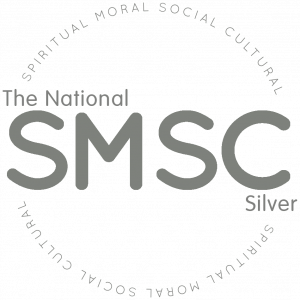
Relationship education is split into the five main areas (families and the people who care for me, caring friendships, respectful relationships, online relationships, being safe), with eight sections of Physical and Mental Health (mental wellbeing, internet safety and harms, physical health and fitness, healthy eating, drugs, alcohol and tobacco, health and prevention, basic first aid and the changing adolescent body).
Our students are inundated with mature content via TV and social media sites and as a result, safety is becoming an increasing concern for parents, making it necessary for students to learn about sexuality and intimate relationships. The Holbrook curriculum teaches all pathways to include lessons about pubertal changes, relationships, and sex education. This provides a safe and secure environment for our students to learn about their bodies, needs, and sexuality. We have tailored learning to match the age and needs of each student.
ICT and Computing at Holbrook School for Autism
At Holbrook School, we recognise the vital role that ICT and Computing play in developing independence, communication and functional life skills for all our learners. Our specialist curriculum is tailored to meet the wide-ranging needs of our students, offering appropriate levels of challenge and support from the earliest stages of learning through to preparation for adulthood.
Across all pathways, our learners access technology in purposeful and meaningful ways. In the Raindrops and Stream pathways, students develop basic interaction skills through cause-and-effect activities, touchscreen apps, and accessible sensory experiences. Learners in the River pathway develop their Accessible ICT skills through structured activities using iPads, laptops and interactive whiteboards. These skills are embedded across the curriculum, linking to subjects like English, Maths, PSHE and My World. Students in the Ocean and Waterfall pathways follow a carefully planned curriculum that covers the three core areas of ICT and Computing: Information Technology, Computer Science, and Digital Literacy.
All students at Holbrook learn about online safety through links to the nationally recognised Project Evolve framework. Online safety is not just taught in lessons but is reinforced through our PSHE curriculum and regular whole-school activities. We also support families with advice, updates and workshops to help them navigate online risks and understand how to keep their children safe in the digital world.
Our older students work towards accreditation through ASDAN units and Essential Digital Skills qualifications, giving them practical, real-world skills such as communicating via email, online shopping, using mobile devices, and safe internet searching—key competencies for adulthood, work and life.
Personal Development at Holbrook School for Autism
Personal Development Overview
The lateral curriculum – ‘My Plans’
Every student has a ‘My Plan’, which is a provision map stating how their outcomes from their EHCP will be met through the school curriculum. The four areas which encompass the learning opportunities are grouped into four areas linking to the SEND code of practice. These are; My Thinking, My Body, My Communication, and My Feelings. The ‘My Plan’ allow all students to be given personalised and relevant learning opportunities and provision.
Students all have a personalised “My Plan” which determines a bespoke curriculum offer required to support student EHCP objectives. The ‘My Plan’ should be a standalone piece of information that gives a quick over view to strategies used to help work towards completing EHCPs; to be updated along with annual reviews. The amount of strategies per area does not have any representation on how much evidence each area should have. It might over time show that some teachers teach more to one area across the whole class and may need to look at timetables and re-adjust their planning.
EHCP folders of evidence are collected on our Seesaw app. To ensure we are referring to high quality pieces of focused evidence teachers create folders for individual students based on their long term EHCP goals. Evidence now collected is evidence towards that goal and can be monitored as thorough evidence at the annual review when reviewing targets. The ‘My Plan’ is then fit for purpose as provision towards achieving these.
The core curriculum team are made up of Lucy Hunt and the pathway leads, Hayley, Lauren and Sam who are happy to discuss the curriculum with your further. Please email info@holbrookschoolforautism.co.uk to get in touch.
